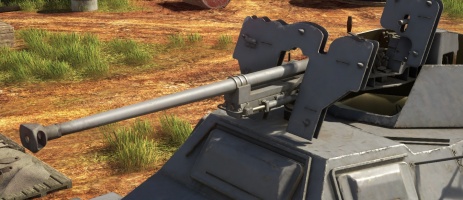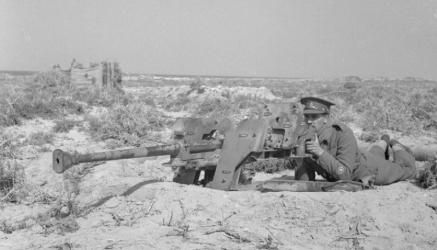Difference between revisions of "S.Pz.B.41 (28/20 mm)"
Inceptor57 (talk | contribs) m (Moved historical image to the now-filled history section) |
Inceptor57 (talk | contribs) m (→History) |
||
| Line 82: | Line 82: | ||
[[File:HistoricImage IWM-E-9090 S.Pz.B.41 (28-20 mm).jpg|x250px|thumb|right|A captured S.Pz.B.41 in the hands of an Englishmen during the North African campaign.]] | [[File:HistoricImage IWM-E-9090 S.Pz.B.41 (28-20 mm).jpg|x250px|thumb|right|A captured S.Pz.B.41 in the hands of an Englishmen during the North African campaign.]] | ||
| − | The s.Pz.B.41's benefit was maintaining a high-velocity penetrating shell at a lighter weight than the [[PaK L/45 (37 mm)|37 mm PaK 36]], with the s.Pz.B.41 weighing 223 kg (~492 lb.) altogether,<ref name="TankArchives_SPzB41"/> while the PaK 36 weighed roughly 400 kg (~880 lb.).<ref name="WarDept_PaK36">War Department 1943, pg.113-114</ref> | + | The s.Pz.B.41's benefit was maintaining a high-velocity penetrating shell at a lighter weight than the [[PaK L/45 (37 mm)|37 mm PaK 36]], with the s.Pz.B.41 weighing 223 kg (~492 lb.) altogether,<ref name="TankArchives_SPzB41"/> while the PaK 36 weighed roughly 400 kg (~880 lb.).<ref name="WarDept_PaK36">War Department 1943, pg.113-114</ref> The s.Pz.B.41 could also be disassembled and carried in a crew of five, further enhancing the weapon's mobility. |
The weapon proved useful in the Eastern Front as a weapon against the Soviet's new T-34 and KV-1 tank. Several were also sent to the North African theater.<ref name="Zaloga2005">Zaloga 2005, pg.6-7</ref> However, the increasing armour on tanks eventually made the s.Pz.B.41 obsolete as a front-line anti-tank weapon by 1943. The s.Pz.B.41's armour-piercing shell being built from tungsten also complicated the weapon's longevity as the material became scarce in Germany.<ref name="LoneSentry_SPzB41"/> However, the weapon remained as a anti-materiel weapon against infantry fortifications and thin-skinned or lightly armoured vehicles.<ref name="TankArchives_SPzB41"/> | The weapon proved useful in the Eastern Front as a weapon against the Soviet's new T-34 and KV-1 tank. Several were also sent to the North African theater.<ref name="Zaloga2005">Zaloga 2005, pg.6-7</ref> However, the increasing armour on tanks eventually made the s.Pz.B.41 obsolete as a front-line anti-tank weapon by 1943. The s.Pz.B.41's armour-piercing shell being built from tungsten also complicated the weapon's longevity as the material became scarce in Germany.<ref name="LoneSentry_SPzB41"/> However, the weapon remained as a anti-materiel weapon against infantry fortifications and thin-skinned or lightly armoured vehicles.<ref name="TankArchives_SPzB41"/> | ||
Revision as of 14:22, 25 May 2021
Contents
Description
The 2.8/2 cm S.Pz.B.41 (Full designation: schwere Panzerbüchse; English: heavy tank hunting rifle) is a German anti-tank gun that utilizes a squeeze-bore principle for the projectile's kinetic energy. The squeeze-bore principle has a varying barrel diameter from the chamber to the muzzle, which "squeezes" the projectile as it propels through the "bore" in order to obtain a higher muzzle velocity. This results in the strange calibre naming for the weapon, which starts at 28 mm diameter at the chamber that steadily decreases to 20 mm by the muzzle end.
Vehicles equipped with this weapon
General info
The 2.8/2 cm S.Pz.B.41 is hindered by the fact that it only has one type of ammunition available in-game, the Pzgr.41 APCR ammunition. However, the squeeze-bore principle does indeed propels the ammunition at an extremely high velocity of 1,400 m/s
Available shells
| Penetration statistics | |||||||
|---|---|---|---|---|---|---|---|
| Ammunition | Type of warhead |
Penetration in mm @ 0° Angle of Attack | |||||
| 10m | 100m | 500m | 1000m | 1500m | 2000m | ||
| 2.8/2cm Pzgr.41 | APCR | 95 | 94 | 66 | 38 | 15 | 8 |
| Shell details | ||||||||||
|---|---|---|---|---|---|---|---|---|---|---|
| Ammunition | Type of warhead |
Velocity in m/s |
Projectile Mass in kg |
Fuse delay
in m: |
Fuse sensitivity
in mm: |
Explosive Mass in g (TNT equivalent): |
Normalization At 30° from horizontal: |
Ricochet: | ||
| 0% | 50% | 100% | ||||||||
| 2.8/2cm Pzgr.41 | APCR | 1,400 | 0.14 | N/A | N/A | N/A | +1.5° | 66° | 70° | 72° |
Comparison with analogues
As of Update 1.87, the S.Pz.B.41 is a one-of-a-kind squeeze-bore weapon in the game that presents high velocity and penetration for the calibre.
A similar weapon that retains a "lightweight" construction and small-calibre shell is the Italian Fucile Controcarri S Mod.39 anti-tank rifle inside the L3/33 CC.
However, in terms of a weapon that have similar penetration power as the S.Pz.B.41 is the British 40 mm OQF 2-pounder, with the Shot Mk.1 APCBC/T that can penetrate 96 mm at point-blank range at perpendicular armour. The firepower parity at such a difference of calibre is testament on just how much faster the S.Pz.B.41 shell is going due to the squeeze-bore princple.
Usage in battles
Describe the cannon/machine gun in the game - its distinctive features, tactics of usage against the main opponents. Please don't write a "guide" - do not impose a single point of view, but give the reader food for thought.
Pros and cons
Summarize and briefly evaluate the weaponry in terms of its characteristics and combat effectiveness. Mark pros and cons as a list.
Pros:
Cons:
History
The concept of a squeeze-bore weapon began in the early 20th century under the proposal of German professor Karl Puff. This materialized into a weapon after World War I by Hermann Gerlich. The design used a conical shell in a barrel that had a narrowing calibre width to "squeeze" the shell to make the most of the propellent energy behind the shell. This resulted in extremely high muzzle velocities, which broke records at the time, but the downside to the design was the high production cost and complexity of producing the barrel design, and the short barrel life due to the stresses involved.[1]
After Gerlich's death in 1934, his designs were picked up by Mauser who continued work on the squeeze-bore weapon. Mauser engineers at Obendorf developed a 28/20 mm weapon in 1939, which was designated the Gerät 231 or MK.8202. This was further developed and trialed in the Summer of 1940 by the Wehrmacht. The weapon was eventually accepted into service in 1941 as the 2,8 cm schwere Panzerbüchse 41, or shortened as s.Pz.B.41.[2] Production of the weapon by Mauser ran between 1940-1943 with a total of 2,782 units produced, with a unit price of around 4,500 Reichsmarks each.[1]
The s.Pz.B.41's benefit was maintaining a high-velocity penetrating shell at a lighter weight than the 37 mm PaK 36, with the s.Pz.B.41 weighing 223 kg (~492 lb.) altogether,[1] while the PaK 36 weighed roughly 400 kg (~880 lb.).[3] The s.Pz.B.41 could also be disassembled and carried in a crew of five, further enhancing the weapon's mobility.
The weapon proved useful in the Eastern Front as a weapon against the Soviet's new T-34 and KV-1 tank. Several were also sent to the North African theater.[4] However, the increasing armour on tanks eventually made the s.Pz.B.41 obsolete as a front-line anti-tank weapon by 1943. The s.Pz.B.41's armour-piercing shell being built from tungsten also complicated the weapon's longevity as the material became scarce in Germany.[2] However, the weapon remained as a anti-materiel weapon against infantry fortifications and thin-skinned or lightly armoured vehicles.[1]
Captured samples of the s.Pz.B.41 by the Allies revived interest in development of tapered-bore designs on the American 37 mm cannon and the British 2-pounder cannon, with the overall goal of improving armour penetration on the same lightweight platforms. However, the design issues of short barrel life and complexity in manufacturing were never overcame, and so none of the experimental designs were accepted into US service.[4]
Media
An excellent addition to the article would be a video guide, as well as screenshots from the game and photos.
See also
Links to the articles on the War Thunder Wiki that you think will be useful for the reader, for example:
- reference to the article about the variant of the cannon/machine gun;
- references to approximate analogues by other nations and research trees.
External links
- [Tank Archives] Schwere Panzerbüchse 41 (Web Archive)
- [Military Factory] Mauser 2.8cm schwere Panzerbuchse 41 (sPzB 41) (Web Archive)
- References
- Bibliography
- Lone Sentry. "'German Antitank Weapons' from Intelligence Bulletin, November 1944." Lone Sentry, n.d., Website Accessed 25 May 2021 (Archive).
- Military Intelligence Service: War Department, German Infantry Weapons. Washington: United States War Department, 25 May 1943.
- Samsonov, Peter. "Schwere Panzerbüchse 41." Tank Archives, Blogger, 20 Aug. 2016, Website. Accessed 25 May 2021 (Archive).
- Zaloga, Steven J. US Anti-tank Artillery 1941-45. Osprey Publishing Ltd., 2005.
| Germany tank cannons | |
|---|---|
| 20 mm | KwK30 · KwK38 · Rh202 |
| 28/20 mm | s.Pz.B.41 |
| 30 mm | MK 30-2/ABM |
| 37 mm | KwK34(t) · KwK36 · KwK38(t) · PaK L/45 |
| 47 mm | Pak.(t)(Sf.) |
| 50 mm | KwK39 · KwK L/42 · PaK38 |
| 57 mm | Bofors L/70 Mk.1 |
| 75 mm | K51 L/24 · KwK37 · KwK40 L43 · KwK40 L48 · KwK42 · KwK44 · KwK44 L/36.5 · PaK39 L48 · PaK40/3 L46 · PaK42 · StuK37 · StuK40 L43 · StuK40 L48 |
| 76 mm | PaK36 (r) |
| 88 mm | Flak.37 · Flak 41 · KwK36 · KwK43 · PaK43 |
| 90 mm | BK90 |
| 105 mm | CN105-57 · Cockerill HP · FMK.4 Modelo 1L · K.18 · KwK L/68 · L7A3 · PzK M57 · StuH42 |
| 120 mm | Rh120 L/44 · Rh120 L/55 · Rh120 L/55 A1 |
| 128 mm | K.40 · KwK44 · PaK44 |
| 150 mm | s.I.G.33 · Stu.H 43 L/12 |
| 380 mm | RW61 |
| Foreign: | |
| 30 mm | Bushmaster 2 Mk.44 (USA) · HSS 831L (Britain) |
| 57 mm | 6pdr OQF Mk.V (Britain) |
| 73 mm | 2A28 (USSR) |
| 75 mm | M3 (USA) |
| 76 mm | F-32 (USSR) · F-34 (USSR) · M32 (USA) |
| 90 mm | M36 (USA) · M41 (USA) |
| 105 mm | GT-3 (South Africa) |
| 125 mm | 2A46 (USSR) |
| 152 mm | M-10T (USSR) · XM150E5 (USA) |
| 155 mm | M126 (USA) |





